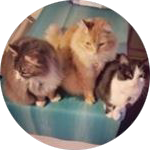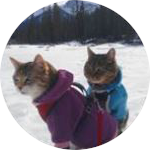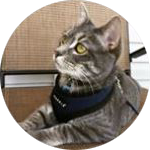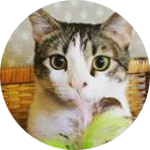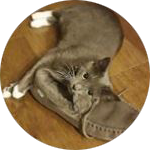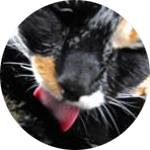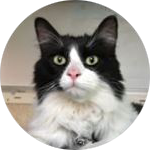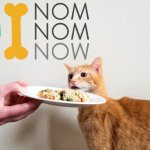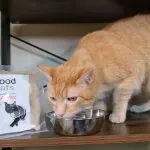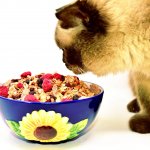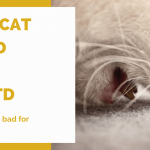15 Minutes with a Veterinary Nutritionist: Your Questions Answered
Last Updated on
When we were given the opportunity to interview Dr. Justin Shmalberg, board-certified veterinary nutritionist and Chief Nutrition Officer at NomNomNow, we knew it was the perfect chance to turn the mic to the pawesome people who follow us. That means you. *waves*
We love the questions we received from our Instagram followers and email newsletter subscribers. It’s awesome to see how much you all care about your cats. Thanks, everyone!
After accepting questions, we sent them off to Dr. Justin Shmalberg and waited for a response. After a couple of days, Dr. Shmalberg’s responses showed up in our email inbox.
Before we get into the questions and answers, let’s learn a little more about the interviewee.
Dr. Justin Shmalberg is a board-certified veterinary nutritionist and Chief Nutrition Officer at NomNomNow, a company that makes fresh pet food and delivers it to your door. He guides NomNomNow in all recipe formulation and advises on pet nutrition to ensure that NomNomNow delivers the absolute best food to the dogs and cats they serve. Dr. Shmalberg is a practicing vet and a clinical associate professor of integrative veterinary medicine at a leading university. He has published numerous scientific papers in veterinary medicine, frequently lectures on nutritional topics to veterinarians and pet owners, and is one of less than 100 board-certified specialists in small animal clinical nutrition in the country. Dr. Shmalberg is a strong believer in the benefits of natural, wholesome food for pets.
15 Minutes with a Veterinary Nutritionist: Your Questions Answered
 yeti_mallow asked: What foods would you feed your pets? Do you believe in a raw diet?
yeti_mallow asked: What foods would you feed your pets? Do you believe in a raw diet?
I feed my pets a fresh, gently-cooked diet that is custom made-to-order for their specific needs. I have often found that my cats and others specifically respond well to a diet which contains adequate moisture, and is high in protein, moderate in fat, and lower in carbohydrates.
 rockstackengrl asked: Why do so many veterinarians disagree with a raw diet, and what can be done to change it?
rockstackengrl asked: Why do so many veterinarians disagree with a raw diet, and what can be done to change it?
Raw feeding continues to be a source of controversy, and there still is not enough research on the potential advantages and disadvantages. I work with a number of cat (and dog) parents that feed raw, but honestly I have not yet been personally convinced that the results of feeding raw diets are any different than those of feeding a similarly-prepared cooked diet. The main advantage cooking affords is the reduction in bacterial contamination that often occurs with modern food processing. It is true that cats appear much less likely to become ill from some of these pathogenic bacteria, but when an animal is very young or compromised by another condition, it can and does occur. As with ingredients, I do not malign any feeding strategy, but this is the perspective I give my clients. I try to assess the overall health of the cat and consider other factors when recommending a diet. Many of the raw feeders with whom I’ve consulted eventually do end up cooking or switching to a commercial fresh diet. We could spend hours on a discussion of all the aspects of raw feeding, but this encapsulates my general individualized philosophy.
adventuresofmikeandlily  asked: How much taurine do cats actually need per day?
asked: How much taurine do cats actually need per day?
Taurine is critical for cats, as most of your readers will know, and it’s a nutrient requirement that helps define them as obligate carnivores. Typically, we think of the concentration of any nutrient per calorie, and in cats, the recommendations depending on the source are between 100-500 mg per 1000 calories. As most cats should eat about 200 calories per day, I typically aim for about 100 mg per cat, per day, for the fresh diets that I formulate.
 piperadventurecat asked: Is grain free food better for cats than food with grains? Does the type of grain matter?
piperadventurecat asked: Is grain free food better for cats than food with grains? Does the type of grain matter?
For cats, my tendency is to reduce the carbohydrate content of the food, so I rarely, if ever recommend grains for cats as there is not often a compelling benefit. Grain-free diets have been popularized by marketers and owners, typically because of their concerns over grain allergies or grain by-products (as opposed to whole grains). For dogs, whole grains can, in some cases, provide valuable nutrients including amino acids, fatty acids, and vitamins. It’s important, however, to distinguish grain-free from carbohydrate-free, as the two aren’t synonymous. While cats can be fed a carbohydrate-free diet, their ancestral diets were not carb-free as they contained starches and plant material that were present in the gut of their prey. Carbohydrates are digested quite readily by cats and often contain compounds with potential health benefits (some call these phytonutrients, and many of these compounds are the ones that also provide color to plant ingredients hence the recommendation for people to eat colorful fruits and vegetables). When I include carbohydrates in cats’ diets I often select whole-food ingredients that provide some of these unique compounds.
mrbiteycat  asked: What’s the best combination/proportion of wet to dry food, especially for a kitty who doesn’t really like wet food?
asked: What’s the best combination/proportion of wet to dry food, especially for a kitty who doesn’t really like wet food?
Cats seem to be most enthusiastic about keeping themselves hydrated when the water is in the food itself. There’s significant scientific and owner interest in knowing the long-term implications of a dry vs. wet food but we just don’t yet have complete information. Certainly we know that providing food with more moisture is helpful in managing kidney disease in cats and in preventing urinary tract issues in cats that may be predisposed to that. I typically advocate for foods, at least in part, that are higher in water. Many cats are what we technically call neophobic, that is to say they fear food items they haven’t seen before. It’s important to start young cats early getting used to different textures and flavors for this reason. Typically, a slow transition to a fresh, wet food can convince even the most stubborn of cats to give it a try. My own adopted cats were raised on kibble before I rescued them, and they took a week or so to come around but are now very sold on the idea of fresh food! In answer to your question about proportion, there’s no critical rule and ultimately this might be decided by your cat, as we all know that cats are the deciders when it comes to what they’ll eat.
little_noodle_big_adventures  asked: There are estimates of how much to feed cat based on body size, but with an asterisk about activity level. With a cat that goes on walks, how do you adjust feeding based on that activity?
asked: There are estimates of how much to feed cat based on body size, but with an asterisk about activity level. With a cat that goes on walks, how do you adjust feeding based on that activity?
A cat that goes on walks or has access to a larger outdoor area will generally burn more calories than a fully-indoor cat but the difference isn’t as big as you might think (10-20%). It’s possible that we’d increase meal portions slightly to compensate, but since every cat is different and needs to have their food intake adjusted to ideal body weight (where they have a waist when you look at them from the top or the side) we typically start with an average of around 200 calories per cat, per day (assuming they are between 7-12 pounds). If you want to keep consistent track of your cat’s weight, you can buy a baby scale inexpensively and use that to keep track of weight. Unless weight gain or loss is dramatic, I typically adjust calories in 10% increments.
Nadine asked: With all of the choices available, I am wondering how to make a good decision about what to feed my furbabies. I would be afraid of preparing their food because I would be afraid that I wouldn’t get the right balance of nutrition. As for using NomNomNow I’m not sure I could afford that. Then in regards to the pet food industry, I’m not sure that I can trust them. There are all the recalls, then they are never very straightforward, also there are so many choices. Just what is the best way to make a good choice?
Of course it’s possible to prepare homemade food for your pet, but for cats, especially, I don’t recommend it without checking for its expected nutrient content (something vet nutritionists like myself do) to be sure you’re feeding all you need to for your specific cat (and each cat is a little different in what may be optimal). It can also be difficult to achieve consistently precise portions when serving and portioning the food yourself.
Regarding the price of fresh diets like NomNomNow, much of the increased cost for innovative fresh pet food comes from the desire to avoid the mistakes that some in the industry have made in the past. There is significant cost when purchasing high quality whole-food ingredients, in performing nutritional testing to confirm that the diets are providing optimal nutrient levels, in carefully cooking foods in a state-of-the-art kitchen, and in individually portioning diets as NomNomNow does. These are some examples of what NomNomNow is doing that really hasn’t been done before. I have found that compared to the time and cost it used to take to prepare home cooked food for my pets, I’ve experienced savings. I certainly understand that diets across the board have been increasing in cost, and this can be a struggle for many people. Our hope at NomNomNow is that, in recommending tailored and portioned diets of the highest quality, we can help keep pets healthy and create cost savings as a result of better overall pet health. At the end of the day, all veterinarians especially want to prevent health issues rather than just treat disease.
Trust in pet foods needs to be earned and maintained, and every company is different. I think pet owners have done a great service in demanding more transparency, and I encourage my clients to contact companies and ask for full nutrient profiles on their diets, to ask about caloric basis (the preferred way to compare pet foods), and to ask how they make decisions on ingredients. Because of these demands, companies are having to become more transparent, which is a good thing for pets and pet parents.
 therealgrainydijonmustard asked: We feed our fur babies homemade food for dinner (mashed veggies and meat+ nutritional yeast and fish oils) but still give them kibble for breakfast to make sure they get all the right supplements- is this really needed it is there some way we can move away from store-bought foods entirely?
therealgrainydijonmustard asked: We feed our fur babies homemade food for dinner (mashed veggies and meat+ nutritional yeast and fish oils) but still give them kibble for breakfast to make sure they get all the right supplements- is this really needed it is there some way we can move away from store-bought foods entirely?
The approach you’re using with your cats is one I see commonly in practice. I call this the “hybrid approach:” basically a combination of fresh foods and commercial diets. Unfortunately, many commercial diets aren’t designed for dilution with other foods, and we can run into deficiencies of minerals and vitamins as a result. I always encourage owners to consult their veterinarian or a veterinary nutritionist, as this is the fastest way to find out if a dietary strategy is appropriate. Also keep in mind it may be difficult to find out if a combination of foods is appropriate for your pet, as some pet food companies may not be willing to say what the nutrient levels are in their food.
 mavericktux asked: How bad for my cat Maverick are Fancy Feast Broths? They look fresh and smell almost like human food but I’ve often heard that common pet food brand names aren’t actually that great for our pets.
mavericktux asked: How bad for my cat Maverick are Fancy Feast Broths? They look fresh and smell almost like human food but I’ve often heard that common pet food brand names aren’t actually that great for our pets.
I try not to disparage any particular food company or feeding strategy, especially because I too often don’t have full information about what certain manufacturers are doing. There are many ways to feed pets, which is why there are so many options! I encourage owners to evaluate each company or diet using the information I provided above. My confidence in NomNomNow stems from the fact that I have a complete picture of what’s happening, whereas some companies aren’t clear about how their ingredients are sourced, how their diets are produced, and how their nutrients are measured.
A HUGE thank you to Dr. Shmalberg and everyone else who made this interview possible!
We don’t necessarily agree with everything Dr. Shmalberg says, but we’re passionate about facilitating conversations about feline nutrition.
Just thirty years ago, the only way to get information about your cat’s health was to spend face time with a veterinarian, read a book, or share ideas with family, neighbors, and friends. Knowledge took years to trickle down from experts and fringe intellectuals to the general population. But all that has changed. Expert knowledge is an email away. With a click, you can listen in on or join the million-voiced conversation about cat care.
In the short lifetime of the internet, we’ve used web communication to dispel myths, communicate with fellow cat guardians, find home remedies, and create a population of cat guardians that’s more educated than that of any past era.
And unless something terrible happens and these channels of free communication are blocked, it can only get better. So thank you, thank you, thank you for every post you make about your cat, for every question you dare to ask or volunteer to answer. With every web search, social media post, DM, and email, you’re helping to make the world a better place for both cats and their people.
Interested in learning more about NomNomNow?
NomNomNow creates fresh, homemade-style cat food from human-grade ingredients and ships the meals straight to your door.
Read our review of NomNomNow here.
If you purchase NomNomNow through links on our site, you’ll receive 50% off of your first order and we’ll receive a percentage of the sale. Thank you for your support!
Remember that you’re covered by NomNomNow’s Care-grade guarantee. If you don’t see a positive difference after 30 days, NomNomNow will pay for your next order ($40 limit).



